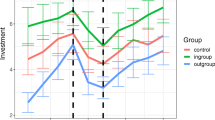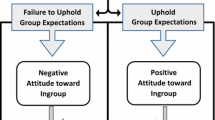Abstract
Previous studies examining the impact of the unethical behavior of a group of colleagues on an individuals unethical behavior have typically employed social learning theory as a theoretical foundation. In this research, we extend these rich yet defective examinations by addressing the largely ignored relationship perspective. Drawing on the social network perspective, we posit that the structure of relationships significantly influences the process of unethical behavior diffusion. Consistent with the theoretically derived hypotheses, our agent-based model simulation results provide general support for our theoretical model: colleagues unethical behaviors positively affect an individuals unethical behaviors, and this influence is positively moderated by group network density, group network closeness centrality and group size. This paper also discusses theoretical contributions, practical values, limitations and directions for future research.







Similar content being viewed by others
Explore related subjects
Discover the latest articles, news and stories from top researchers in related subjects.References
Aiken LS, West SG (1991) Multiple regression: testing and interpreting interactions. Sage Publishing House, Newbury Park, CA
Bandura A (1976) Social learning theory. In: Spence JT, Carson RC, Thibaut JW (eds) Behavioral approaches to therapy. General Learning Press, Morristown, NJ, p 1C46
Bandura A (1986) Social foundations of thought and action: a social cognitive theory. Prentice-Hall, Englewood Cliffs, NJ
Baron RM, Kenny DA (1986) The moderator-mediator variable distinction in social psychological research: conceptual, strategic, and statistical considerations. J Pers Soc Psychol 51:1173–1182. doi:10.1037/0022-3514.51.6.1173
Bartels KK, Harrick E, Martell K, Strickland D (1998) The relationship between ethical climate and ethical problems within human resource management. J Bus Ethics 17:799–804. doi:10.1023/A:1005817401688
Beams JD, Brown RM, Killough LN (2003) An experiment testing the determinants of non-compliance with insider trading laws. J Bus Ethics 45:309–323. doi:10.1023/A:1024159730463
Borgatti SP, Everett MG, Freeman LC (2002) UCINET for windows: software for social network analysis. Analytic Technologies, Harvard
Brass DJ, Butterfield KD, Skaggs BC (1998) Relationships and unethical behavior: a social network perspective. Acad Manag Rev 23:1–18. doi:10.5465/AMR.1998.192955
Carletti T, Righi S, Fanelli D (2011) Emerging structures in social networks guided by opinions’exchanges. Adv Complex Syst 14:13–30. doi:10.1142/S021952591100286X
Davis TRV, Luthans F (1980) A social learning approach to organizational behavior. Acad Manag Rev 5:281–290
Fernández-Márquez CM, Vázquez FJ (2014) A simple emulation-based computational model. Jasss-J Artif Soc S 17:1–23
Freeman LC (1978) Centrality in social networks: conceptual clarification. Soc Netw 1:215–239. doi:10.1016/0378-8733(78)90021-7
Gino F, Ayal S, Ariely D (2009) Contagion and differentiation in unethical behavior: the effect of one bad apple on the barrel. Psychol Sci 20:393–398. doi:10.1111/j.1467-9280.2009.02306.x
Gino F, Galinsky AD (2012) Vicarious dishonesty: when psychological closeness creates distance from ones moral compass. Organ Behav Hum Dec 119:15–26. doi:10.1016/j.obhdp.2012.03.011
Granovetter M (1992) Networks and organization: structure form and action. Harvard Business School Press, Boston, pp 25–36
Hosmer LT (1987) The institutionalization of unethical behavior. J Bus Ethics 6:439–447. doi:10.1007/BF00383286
Ivancevich JM, Konopaske R, Matteson MT (2005) Organizational behavior and management. Irwin Publishing House, McGraw-Hill, Boston, MA
Jones GE, Kavanagh MJ (1996) An experimental examination of the effects of individual and situational factors on unethical behavioral intentions in the workplace. J Bus Ethics 15:511–523. doi:10.1007/BF00381927
Jones TM (1991) Ethical decision making by individuals in organizations: an issue-contingent model. Acad Manag Rev 16:366–395. doi:10.5465/AMR.1991.4278958
Keith NK, Pettijohn CE, Burnett MS (2003) An empirical evaluation of the effect of peer and managerial ethical behaviors and the ethical predispositions of prospective advertising employees. J Bus Ethics 48:251–265. doi:10.1023/B:BUSI.0000005786.09105.5c
Kish-Gephart JJ, Harrison DA, Treviño LK (2010) Bad apples, bad cases, and bad barrels: meta-analytic evidence about sources of unethical decisions at work. J Appl Psychol 95:1–31. doi:10.1037/a0017103
Knoke D, Yang S (2007) Social network analysis. SAGE Publications Incorporated, Los Angeles
Kohlberg L (1969) Stage and sequence: the cognitive-developmentalapproach to socialization. In: Goslin DA (ed) Handbook of socialization theory and research. Rand McNally, Chicago, pp 347–480
Kraatz MS (1998) Learning by association? Interorganizational networks and adaptation to environmental change. Acad Manag J 41:621–643. doi:10.2307/256961
Kulik BW, OFallon MJ, Salimath MS (2008) Do competitive environments lead to the rise and spread of unethical behavior? Parallels from Enron. J Bus Ethics 83:703–723. doi:10.1007/s10551-007-9659-y
Liverpool Tasie LSO, Winter NA (2011) Asset versus consumption poverty and poverty dynamics in rural Ethiopia. Agric Econ 42:221–233. doi:10.1111/j.1574-0862.2010.00479.x
Liviatan I, Trope Y, Liberman N (2008) Interpersonal similarity as a social distance dimension: implications for perception of others actions. J Exp Soc Psychol 44:1256–1269. doi:10.1016/j.jesp.2008.04.007
Mayer DM, Aquino K, Greenbaum RL, Kuenzi M (2012) Who displays ethical leadership, and why does it matter? An examination of antecedents and consequences of ethical leadership. Acad Manag J 55:151–171. doi:10.5465/amj.2008.0276
McCabe DL, Butterfield KD, Trevino LK (2006) Academic dishonesty in graduate business programs: prevalence, causes, and proposed action. Acad Manag Learn Edu 5:294–305. doi:10.5465/AMLE.2006.22697018
Miller JH, Page SE (2004) The standing ovation problem. Complexity 9:8–16. doi:10.1002/cplx.20033
Moore C, Gino F (2013) Ethically adrift: how others pull our moral compass from true north, and how we can fix it. Res Organ Behav 33:53–77. doi:10.1016/j.riob.2013.08.001
O’Fallon MJ, Butterfield KD (2005) A review of the empirical ethical decision-making literature: 1996–2003. J Bus Ethics 59:375–413. doi:10.1007/s10551-005-2929-7
O’Fallon MJ, Butterfield KD (2011) Moral differentiation: exploring boundaries of the monkey see, monkey do perspective. J Bus Ethics 102:379–399. doi:10.1007/s10551-011-0820-2
O’Fallon MJ, Butterfield KD (2012) The influence of unethical peer behavior on observers unethical behavior: a social cognitive perspective. J Bus Ethics 109:117–131. doi:10.1007/s10551-011-1111-7
Palmer D (2008) Extending the process model of collective corruption. Res Organ Behav 28:107–135. doi:10.1016/j.riob.2008.04.005
Rienties B, Hliot Y, Jindal-Snape D (2013) Understanding social learning relations of international students in a large classroom using social network analysis. High Educ 66:489–504. doi:10.1007/s10734-013-9617-9
Robinson SL, OLeary-Kelly AM (1998) Monkey see, monkey do: the influence of work groups on the antisocial behavior of employees. Acad Manag J 41:658–672. doi:10.2307/256963
Scott J (1991) Social network analysis: a handbook. Sage Publications, Newbury Park, CA
Sonenshein S (2007) The role of construction, intuition, and justification in responding to ethical issues at work: the sensemaking-intuition model. Acad Manag Rev 32:1022–1040. doi:10.5465/AMR.2007.26585677
Treviño LK (1986) Ethical decision making in organizations: a person-situation interactionist model. Acad Manag Rev 11:601–617. doi:10.5465/AMR.1986.4306235
Treviño LK, Weaver GR, Reynolds SJ (2006) Behavioral ethics in organizations: a review. J Manage 32:951C990. doi:10.1177/0149206306294258
Umphress EE, Bingham JB, Mitchell MS (2010) Unethical behavior in the name of the company: the moderating effect of organizational identification and positive reciprocity beliefs on unethical pro-organizational behavior. J Appl Psychol 95:769C780. doi: 10.1037/a0019214
Weber J (1990) Managers moral reasoning: assessing their responses to three moral dilemmas. Hum Relat 43:687C702. doi: 10.1177/001872679004300705
Zuber F (2015) Spread of unethical behavior in organizations: A dynamic social network perspective. J Bus Ethics 131:151C172. doi: 10.1007/s10551-014-2270-0
Author information
Authors and Affiliations
Corresponding author
Rights and permissions
About this article
Cite this article
Wang, D., Pi, X. & Pan, Y. The interpersonal diffusion mechanism of unethical behavior in groups: a social network perspective. Comput Math Organ Theory 23, 271–292 (2017). https://doi.org/10.1007/s10588-016-9226-0
Published:
Issue Date:
DOI: https://doi.org/10.1007/s10588-016-9226-0




